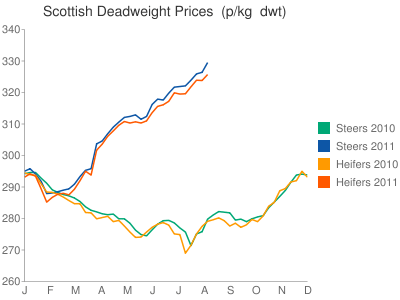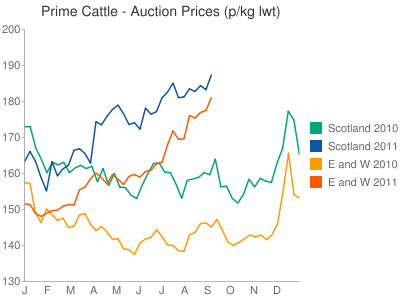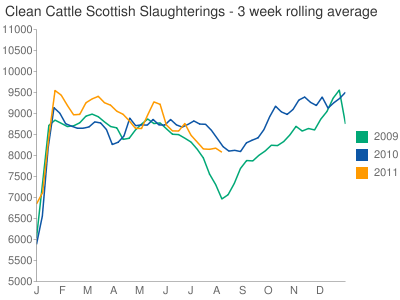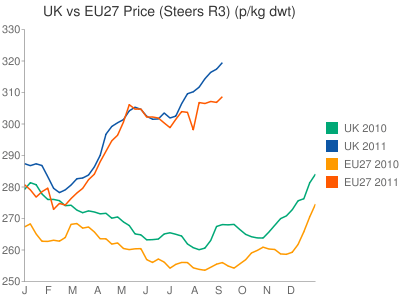



QMS Cattle Market Report - September 2011
During August, prime cattle producer prices continued the upwards trend that they have been exhibiting since the beginning of February, writes Iain Macdonald from Quality Meat Scotland.Deadweight prices for steers are up 50p/kg on the year (18 per cent), and the average auction price for prime cattle in Scotland is 17.5 per cent higher than it was at the end of August 2010.

Scottish abattoir data for July continued to show a significant tightening in prime cattle throughputs. Despite the cummulative prime kill running three per cent ahead of last year the year on year increase has been narrowing since April.
In deed the July kill was 3.5 per cent lower than last year, the second successive month to show a lower kill than last year. Driving the reduction was a fourth consecutive month where fewer steers were killed, while young bull throughputs fell below year earlier levels for the first time.
Although the Scottish steer kill over the first seven months of the year has now fallen behind 2010 levels, the heifer kill remains nearly six per cent higher.

Defra slaughter statistics for the UK show a similar pattern to that found in Scotland. UK throughputs of prime cattle are still running four per cent ahead of last year, although for the first time this year the July kill was lower than the same month last year.
Within the three categories of prime cattle, recent data is showing convergence between the UK and Scottish trends. Steers and young bulls are now in shorter supply although there are still more heifers on the market than this time last year.
In contrast, the culling of mature stock continues at high levels. A combination of high prices, cull cow prices are some 30 per cent higher than last year, and high feed costs continue to give farmers an incentive to remove any unproductive breeding animals from their herds. Throughputs of cows and bulls in the seven-months ending July exceeded levels in the same period of 2010 by more than 21 per cent.

Across Europe, prime cattle prices picked up marginally during August with steers, cows and heifers rising by approximately one per cent and young bulls by 2.5 per cent. Over the past couple of months British prices have grown at a faster rate than the EU averages, with a slight strengthening of Sterling accounting for some of this divergence. Tight supplies across the continent have kept prices well ahead of last year.

In the first half (H1) of 2011 UK beef exports were up nearly 40 per cent year-on-year according to provisional Revenue & Customs (HMRC) data. At 67,350 tonnes, shipments were 19,000t higher than in H1 2010. The combination of a weaker Pound and an expansion of domestic production volumes have supported this sharp increase.
While deliveries to Germany and Italy have decreased by 8.5 per cent and 11.5 per cent respectively compared to H1 2010, Belgium, France and Ireland have all bought 25-30 per cent more British beef and 55 per cent more was sent to the Netherlands.
By contrast deliveries of overseas origin beef to the UK fell by 3.5 per cent during H1. The rise in domestic production volumes has reduced the requirement for imports in spite of the jump in exports.
Nevertheless, the entire decline in imports has been in frozen beef with fresh beef figures essentially matching 2010 levels. The likely contributor to this change has been the greater cow kill which has reduced the requirement for imports of manufacturing beef. This is reflected in the trade data with Ireland for example where over the first half of 2011 there has been a 25 per cent contraction year-on-year in frozen deliveries but a three per cent increase in fresh product.
During June imports of beef from Australia and New Zealand continued to rise when compared with last year. Increased shipments of beef from Oceania have replaced imports from Botswana, which has been shut out of the EU market since February on sanitary grounds. In terms of South American suppliers, Uruguay sent its largest monthly volume since January 2010, while more beef came from Argentina than a year earlier.


